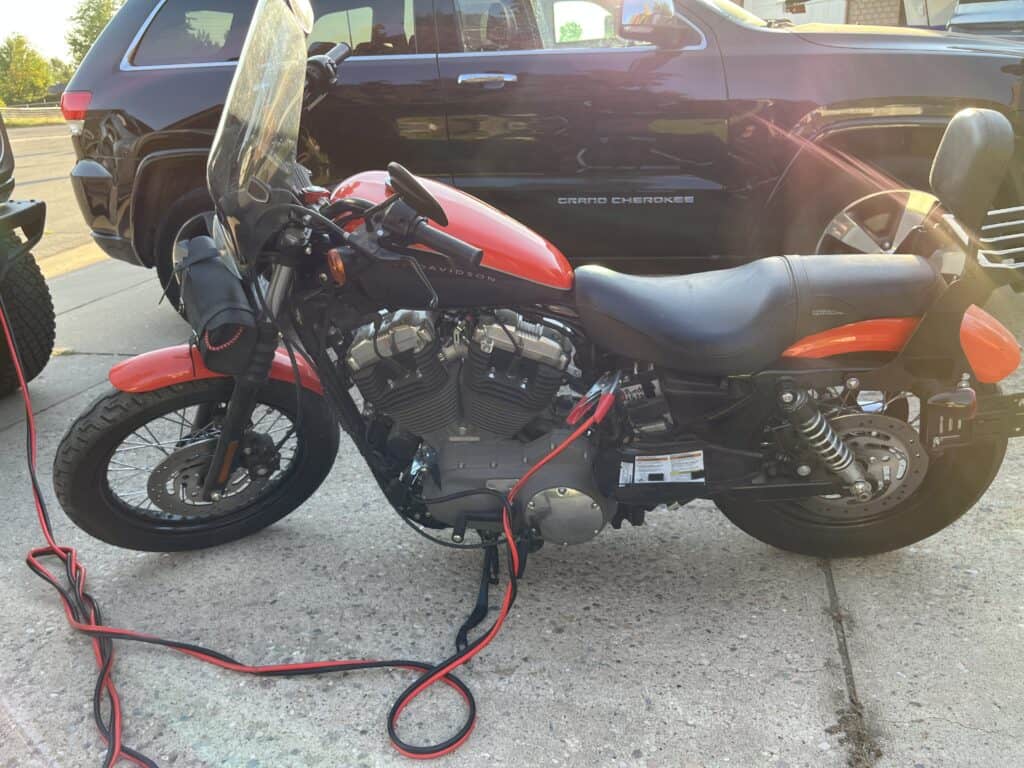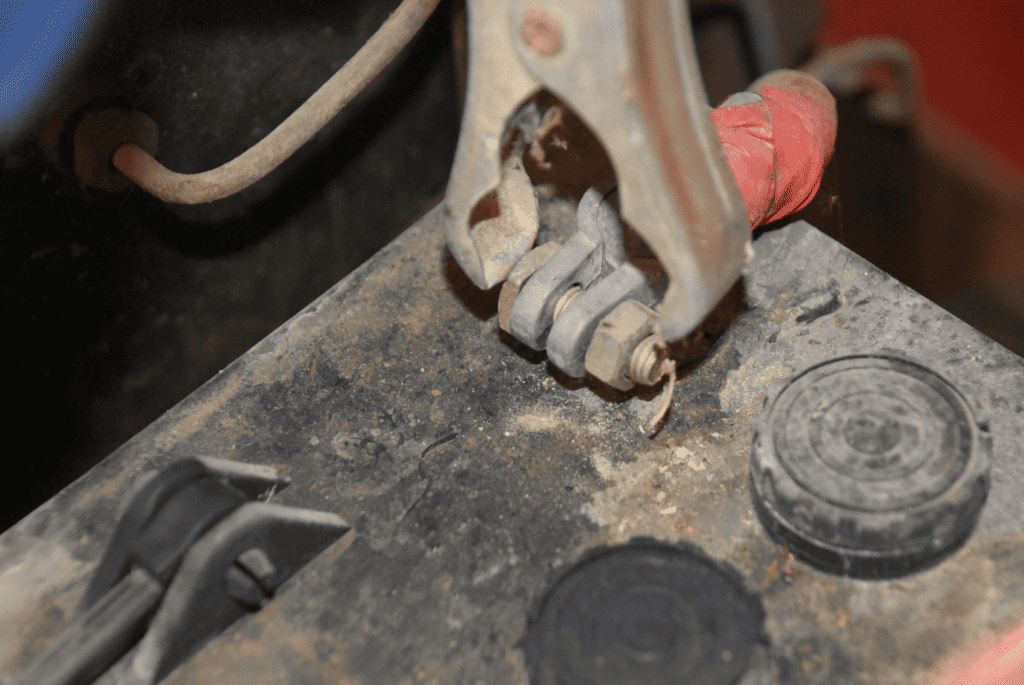
Most modern motorcycles utilize electronic components to operate, such as a starter, fuel injection systems, digital dash displays, and so on. These electronic systems need a battery source in order to operate properly. Batteries are usually pretty durable and reliable, but they do have their own problems. Perhaps the most common issue is the battery inadvertently losing charge.
Can I start my motorcycle while it’s charging? If you are using the jumpstart method to charge your motorcycle, it is okay to start it while it is charging. If you are using a slow charging method such as a trickle charger, it is best practice to remove the charger first then attempt to start your motorcycle.
This article will look into starting up a motorcycle while the battery is being charged. It will look into how to set up a charger on a motorcycle, what the effect of starting with a charger might be, and what to do after the motorcycle is started.
Can I Start My Motorcycle While Charging?
If the battery on your motorcycle is dead, the only thing you can do for it is to charge up the battery. The first thing to try is to jump start it. In this case, it is perfectly fine to start the bike while charging. Most newer battery chargers have a jump start setting that pushes a lot of amps to help the starter spin. They will also have a timer or automatic shut off so that the battery isn’t overcharging from all the amps.
If jump starting doesn’t work, it probably means the battery needs to charge more slowly. A slow charge can help recover some of the capacity of the battery. High amp charging tends to warm up the battery, which isn’t good for the battery’s health. While slow charging, it is best not to try and start the motorcycle until the battery is adequately charged. After using a trickle charger, remove it before starting the motorcycle.
If the battery is not taking a charge, the last effort before replacing the battery is to try and recondition it. Reconditioning a battery breaks down the crystalized electrolyte inside the battery cells. Some battery chargers have a mode that can recondition a battery provided it’s not too far gone.
Generally, if the battery is above 10 volts, it can be saved. Using a charger to recondition it requires removing the battery from the motorcycle and hooking up the leads and starting the charger. A battery can be manually reconditioned by emptying out the electrolyte from each cell, cleaning the cells, and replacing the fluid.
Beyond that, the battery is probably bad and requires replacement. Most parts stores will take old batteries for recycling and can offer new and upgraded batteries. They come charged and ready to get the bike up and running.
Can My Battery Overcharge If It’s Running While Plugged In To A Charger?
The worry for starting the motorcycle with the charger going is the idea that there will be too much power coming from the charger and alternator. Overcharging is not good for the battery or any electrical components. However, this shouldn’t be a concern if the battery charger is connected properly and is connected only for a few minutes after starting. The alternator has a built-in regulator to prevent overcharging and most newer chargers also have a built-in system to limit overcharging.
A voltage regulator does just what it says: regulates voltage. This component is usually plugged into the alternator but is mounted separately. At its core is a resistor which is connected in series with a diode. The diode converts the AC voltage of the charging system into DC voltage and the resistor limits the amount of voltage being generated. There are electronically controlled systems in a lot of newer vehicles, but the essence is the same. While a regulator can go bad, it is not a common issue and isn’t usually a difficult repair.
The concern of overcharging is still valid. Overcharging a battery is not good for it because it tends to overheat the battery. There is also the concern that some wiring may be overloaded and will melt or burn. Applying too much power can be an honest mistake since most battery chargers are built for car batteries, which require more amperage than a motorcycle battery.
However, it would be difficult to find a charger that doesn’t have a low amperage setting, which only flows about 2 amps to trickle charge the battery. Perhaps some older chargers can be like this, so be aware of how the charger works.
Another thing to consider about the issue of accidental overcharging is the fact that the starter needs a lot of power to work properly. If it is getting power from whatever the battery can output plus whatever the charger is set to, there’s no concern of too much power. The concern comes after the bike is running and the alternator is charging the battery. But as mentioned, there is a regulator to limit the alternator plus you will probably disconnect the charger once the motorcycle is running.
Can This Ruin The Charger?

No, starting the motorcycle with the charger connected shouldn’t ruin the charger. If it’s a quality charger, there won’t be any crossed wires that will be damaged. As mentioned previously, the starter wants all the power it can get and the charger is outputting however much it is set to.
The most common way a charger is ruined is probably physical damage. The cheaper models aren’t built as well and can break and ruin the delicate electronics inside. Another way that can damage a charger is hooking up the leads the wrong way. This will probably do more damage to the battery, but it can also burn the clamps or short out a circuit inside the charger. However, these are unlikely scenarios if proper care is taken.
Do I Need To Wait A Certain Amount Of Time Before Starting A Motorcycle That’s Charging?
The amount of time to wait for charging depends on the condition of the battery. A battery with lower voltage will take longer than one that is closer to 12 volts. There are three ways to charge a battery: trickle charge, jump start, or boost.
A trickle charge uses low amperage to gradually bring the battery up to proper voltage. Usually the amperage is 1-3 amps applied over a long time. This can take several hours depending on the battery, but it is the best approach for maintaining the battery’s quality. The slow trickle of amperage keeps the temperature lower and is easier on the electrolyte.
The drawback is that it does take quite a while. It may be an all day affair to slowly charge up the battery. While most newer chargers have built in shut off systems, it’s smart to check on the battery periodically for any excess heat or swelling, which indicates that the battery is internally bad.
On the opposite end of the spectrum, jumping a battery is the quickest way to charge it up. This involves applying a high amperage to quickly bring the battery up to voltage so that the motorcycle can start up. This takes only a minute maximum to do, which is convenient in a pinch. However, this is not a good way to charge a completely dead battery. The high amperage will almost certainly cause excess heat which can cause problems for the battery and the charger. Most chargers with a jump start function will have a timer or other shutoff for the jump start function to protect the battery and starter.
The third way, which is using a booster to charge your motorcycle battery, sits in between the two. Sometimes, a battery can be low enough to not start the motorcycle, but not so low that it needs to trickle charge. Though this seems like the best option, it has its place. Maybe if the starter can spin a bit but not quite fast enough. Or perhaps there is a fueling issue and the motorcycle needs to crank a lot in order to fire up.
Regardless, this mid range approach will apply 10 – 40 amps depending on the charger. It’s enough to jump up the battery voltage without it taking all day. If this level is used, it should not be left unattended because it will likely cause overcharging if left for an extended time.
Should I Immediately Remove The Charger After Starting The Motorcycle?
It is probably best practice to disconnect the charger after starting for a few reasons. First, the reason a charger is being used is because the battery was too low to start the motorcycle. So, if the battery gets charged enough and the motorcycle is running, the charger is no longer needed. The likely scenario is that you disconnect the charger, put whatever parts back on the bike, and take off.
The second reason is that disconnecting the charger will also be a test to see how well the motorcycle’s charging system is working. In a lot of cases, if the battery dies, then the motorcycle will die as well. If the motorcycle only runs while the charger is connected and running, it probably means that there is an issue that needs fixed, such as a bad alternator or some kind of wiring issue. In fact, there are some battery chargers that have an alternator test function that can verify this issue. You can see our other article here that discusses why a motorcycle battery isn’t charging.
